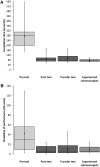A novel training device for tip control in colonoscopy: preliminary validation and efficacy as a training tool
- PMID: 28593418
- PMCID: PMC5715030
- DOI: 10.1007/s00464-017-5617-7
A novel training device for tip control in colonoscopy: preliminary validation and efficacy as a training tool
Abstract
Background: Effective control of the colonoscope tip is one of the most fundamental components of colonoscopy skill. Mastering fine tip control can be problematic for novice trainees, yet no validated training regimes exist for developing this specific skill component in isolation. We aimed to conduct a preliminary validation of a novel training device for colonoscopic tip control, and to assess its efficacy as a training tool.
Methods: In study 1 (validation), 13 experienced colonoscopists and 16 novices used a colonoscope to accurately track 28 targets on each of four concave "training surfaces" as quickly as possible, and we compared their performance. In study 2 (pre-post-training study), another 16 novices were tested before and after a six-session training program. In both studies, the main outcome measurements were completion time (measured automatically by the device) and variability of individual performance (the SD of each individual's completion times across trials).
Results: Compared with novices, experienced colonoscopists were faster (P < 0.0001) and their performances less variable (P < 0.0001). With training, novices became faster (P < 0.0001) and more consistent (P = 0.003), and these improvements also generalized to novel training surfaces (P's < 0.01). After training, the novices' tip control performance was indistinguishable from that of the experienced colonoscopists (P's > 0.05). The composite measures of completion time used in both studies all had acceptable to excellent internal consistency reliability (α's ranged from 0.72 to 0.93).
Conclusions: We found that performance measures derived from using the device to assess skill can discriminate between experienced colonoscopists and novices in terms of their ability to control and guide the colonoscope tip precisely, providing preliminary evidence to support the construct validity of the metrics. The device is also an effective training tool for this fundamental component of colonoscopy skill.
Keywords: Colonoscopy; Motor skill; Skill assessment; Tip control; Training.
Conflict of interest statement
Stephan Riek, Andrew Hill, Annaliese M. Plooy, Mark S. Horswill, Alanna St. G. Cresp, Welber Marinovic, Melany J. Christofidis, Robin Burgess-Limerick, Guy M. Wallis, Marcus O. Watson, and David G. Hewett have no conflicts of interest or financial ties to disclose.
Figures



References
-
- Anderson JT. Teaching colonoscopy. In: Waye JD, Rex DK, Williams CB, editors. Colonoscopy: principles and practice. Malden: Blackwell; 2009. pp. 141–153.
Publication types
MeSH terms
Grants and funding
LinkOut - more resources
Full Text Sources
Other Literature Sources
Medical

